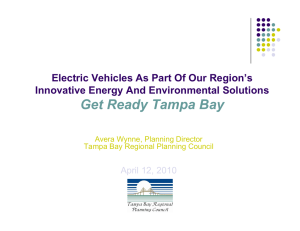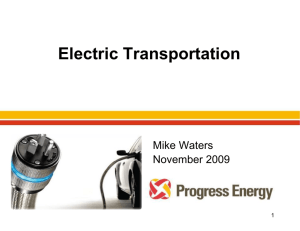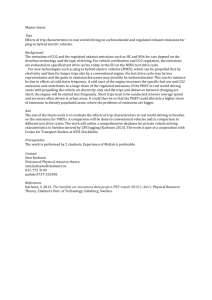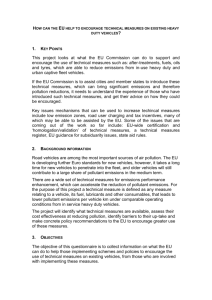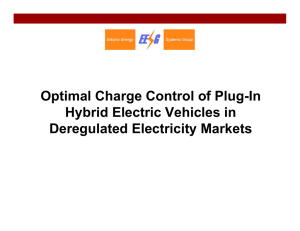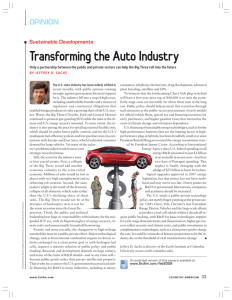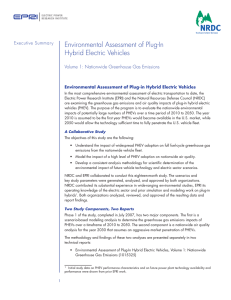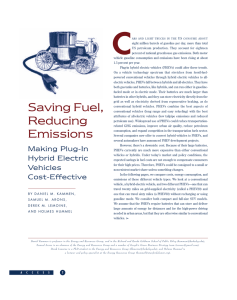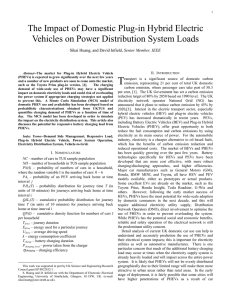Electric Vehicles As Part Of Our Region’s Innovative Energy And Environmental Solutions
advertisement
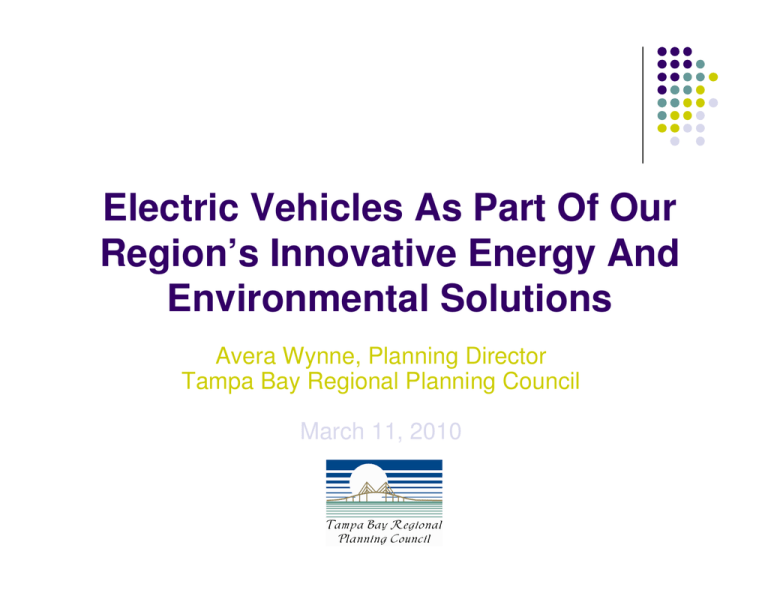
Electric Vehicles As Part Of Our Region’s Innovative Energy And Environmental Solutions Avera Wynne, Planning Director Tampa Bay Regional Planning Council March 11, 2010 Acknowledgments Alternative Energy and Innovative Technologies A Broad Array of Renewable Energy Projects: Solar PV Solar Photovoltaics Econlockahatchee (Econ) Solar Generation Study SolarWise for Schools Solar Thermal Solar Water Heating with EnergyWise Residential solar thermal end-use study Electric Transportation Solar Thermal Plug-In Electric Vehicles DSM – Smart Grid Next Generation Load Management 3 Electric Transportation There Are Several Types Of Electric Vehicles z Hybrid Conversions z z Dual-Mode Plug-in Hybrid (PHEV) z z Gas engine and electric motor work together to optimally power the drive train Toyota Prius Extended Range Electric Vehicle (E-REV) z z Standard hybrids converted to plug-in with an aftermarket battery kit Capable of medium range, high speed all-electric drive with small engine as back-up generator Battery Electric Vehicles (BEV or EV) z Chevy Volt Greater battery capacity for long range, all-electric drive and no back up engine Tesla Roadster 4 PHEV or EREV ALL ELECTRIC ? GM PHEV Chevrolet Volt Toyota Prius ? Nissan Leaf Smart Mitsubishi iMIEV ? Cadillac Converj BYD 3DFM Ford Escape PHEV BMW Concept Hyundai Blue-Will Volvo C30 Fisker Karma VW Golf TwinDrive Kia Ray Ford Focus Chrysler/Fiat EV Mercedes BlueCell Ford Transit Connect Mini-E Tesla Model S Tesla Subaru R1e Toyota FT-EV PHEV / EV Release Timeline ? ? http://www.pluginamerica.org/plug-in-vehicle-tracker.html Pros and Cons of EVs Pros z Reduced emissions. z z z Much lower per mile operating cost. Reduced reliance on imported petroleum products. z z Some vehicles by 2/3 Utilities are switching to NG and other cleaner fuel mixes. Potential use of renewable energy z Electric utilities use many sources of energy to generate electricity. Cons z z All Electrics (EVs) can have range issues. “Range Anxiety” Limited “public” places to plug in. z z Initial purchase prices may be higher than comparable ICE vehicles. z z But 80% charging done at home Especially without incentives Public concern over disposal of spent batteries z Newer type batteries are less toxic 8 PHEV Benefit Analysis Technology MPG Cost / Mile* PHEV 22 miles / 70 cent charge $0.031 Hybrid 46 mpg $0.054 Standard ICE 25 mpg $0.10 •Analysis Utilizes $2.50 Retail Gasoline Price and $0.138 / kWh Charge •30 – 40 mile electrically assisted driving range when using a combination of battery pack and internal combustion engine (ICE) •PGN results: Initially ~ 22 mile all electric range, pre software upgrade. Mid – upper 20s, post installation. 8 22 MPGe Emissions Comparison Prius PHEV: 5 kWh charge* x 1.327 lbs CO2 / kWh** = 6.64 lbs CO2 Standard Passenger Vehicle**: 1 gal fuel x 19.4 lbs CO2 / gal = 19.4 lbs CO2 Reduction of greenhouse gas = 66% * Assumes use of A123 Systems / Hymotion battery module ** Assumes PEF system average *** Fuel economy based on 22 mpg vehicle 9 Concern: “Charging vehicles from the grid will lead to an increase in net emissions.” Response: What the industry calls "well-to-wheel" emissions (including greenhouse gases) for gridpowered vehicles is far lower than gasoline, even for the American power grid (which is 50 percent coal). Cars charging off-peak will use power from plants that can’t turn off at night. Many parts of the country get most of their power from cleaner sources such as natural gas and hydropower. It’s far easier to improve centralized power stations than millions of aging cars. Finally, plug-in electric vehicles recharged from rooftop photovoltaic systems, wind, or nuclear would have virtually zero emissions. 2011 Chevy Volt – E-REV Technology GM’s Board of Directors approved the production of the Chevrolet Volt. The targeted launch date is late 2010 as a 2011 model. Chevy Volt E-REV* Technology *Extended-Range Electric Vehicle Smart Grid: Connecting PHEVs to Home, Office, and Anywhere in Between “A revolution in smart electronics is going to give consumers unprecedented ability to control energy consumption and save money.” The Wall Street Journal September 29, 2008 NRDC & EPRI Natural Resources Defense Council (NRDC) & Electric Power Research Institute (EPRI) Report: PHEVs would reduce greenhouse gases 7 % - 46 % in all nine scenarios (various grid carbon intensity and PHEV penetration) studied and 9 billion tons cumulatively by 2050 Capacity vs Demand The existing off-peak electrical capacity could fuel daily commutes for 73% of all U.S. cars, trucks, SUVs, and vans as PHEVs.* *Source: U.S. Dept. of Energy, 2007: Impacts Assessment of Plug-in Hybrid Vehicles on Electric Utilities and Regional U.S. Power Grids Environmental Impact 2 Environmental Studies z EPRI / Natural Resources Defense Council z z z z Modeled 9 scenarios through 2050 (3 PHEV penetration scenarios x 3 generation carbon scenarios) All 9 scenarios had lower GHG than conventional vehicles Cumulative GHG reductions range from 3.4B to 10.3B metric tons UNC Center for Sustainable Enterprise z z z z z “…PHEVs have the potential to improve air quality and to substantially contribute to meeting our long term GHG reduction goal of 80% below 1990 levels by 2050.” Modeled penetration and utility impact of PHEVs in PEF territory through 2030 Net CO2 emissions decrease over 50% SO2 emissions governed under a cap system NOx emissions decrease Potential to reduce emissions further by charging PHEVs from renewables and nuclear sources Petroleum Reduction PNNL study concluded half of oil imports could be displaced with 73% fleet adoption of PHEVs From PNNL report "Impacts Assessment of Plug-in Hybrid", Kintner-Meyer et. al., 2006 17 Pacific NW National Lab analysis confirms air quality improvements CO2 emissions reduced by 27% NOx emissions reduced by 31% SO2 cap/trade system will prevent an increase in emissions Urban air quality emissions greatly reduced: 18 VOCs/NOx/CO reduced > 90% PM by 40% SO2 by 80% Are We Ready To Plug In? 120 VAC standard plug 19 Q and A on the Nissan Leaf z Q: What is the acceleration and top speed of this car? z z Q: When will the LEAF be available in the U.S.? z z A: The battery will charge in 4-8 hours on a 220V home charging unit. At quick-charge stations, it will charge to 80% in about 26 minutes. Q: How far can you drive on a single charge? z z A: The LEAF will be on the road in some states in 2010. Mass-production will begin in 2012. Q: How long does it take to charge the battery? z z A: The LEAF handles and accelerates like a V6 car and has a top speed of up to 90mph. A: The LEAF will have a range of 100 miles per charge under average, everyday driving conditions. Q: How much will the LEAF cost? z A: At this point, we’re unable to give an exact price, but we’re targeting a price in the range of other typical family sedans. Q and A: General z z z Q. Where will most charging be done? z A. At home. Home charging can be accelerated with 240 charging stations. Q. When we will we see a lot of EVs on the road? z A. White House has set a target of 1 Million EVs by 2015. z A. Some studies have used an estimated 25% penetration by 2050. Q. Is there money available to help “get ready?” z A. Tax Credits z z z z Up to $7,500 tax credit for light duty vehicles 10% tax credits for conversions Up to 50% credits for infrastructure A. Stimulus money and other DOE monies are sometimes available for infrastructure. Project Get Ready: Education, Outreach and Collaboration Initiative led by Rocky Mountain Institute Focus on helping cities/local regions identify barriers and propose solutions Created a menu list of options Must have, nice to have, etc. Provides a forum to interact with other partner cities and technical advisors Participants must provide time commitment 22 Sample Key Objectives: The project will facilitate the adoption of electric vehicles in Tampa Bay by accomplishing these five key objectives: z FACILITATE stakeholder working groups to identify opportunities and explore/resolve issues and barriers associated with electrified transportation. z EDUCATE the community and promote networking opportunities in order to enhance the viability of plug-in electric vehicles. z ESTABLISH sound infrastructure to deliver a network of charging stations that meet the needs of vehicle owners without jeopardizing the stability of the power grid. z DEVELOP relationships with manufacturers of vehicles and charging components to encourage their participation in the Tampa Bay market. z EXPLORE opportunities to enhance success through investments in research, development and demonstration projects. Technical Advisory Group Roles and Activities z z z z z z z z Collaborate and Incubate ideas Marketing Public outreach and education Get fleet managers and businesses involved Promote installation of vehicle-charging stations. Update local codes Educate electricians and building inspectors to expedite the permitting process. Help expedite the standardization of codes and charging facilities avera@tbrpc.org Some of Our Goals • • • • • • Get Tampa Bay electric car “ready.” Attract OEMs to Tampa Bay Positive economic impact and green jobs growth Reduce vehicle emissions Increase use of alternative and/or innovative energy Increased energy independence The T. Boone of Brazil Timeline z z z z z z z z z March 10 – Tele-Conference with RMI March 11 - Present to ABM March 11 - Coordinate Utility Partners March - Coordinate OEM Partners April 12 - TBRPC Adopts Project Get Ready Resolution z TBRPC is the Champion for getting Tampa Bay EV ready. April – Mid May – Assemble TAG April – Mid May – Assemble commitments z RMI, Utilities, OEMs, TAG representatives and local governments Mid May – TAG begins meeting June ? – Project Get Ready Media Event z EV car demonstrations, agreement signings, etc.!! avera@tbrpc.org
